Interrogating Invention: Electronic Café and the Politics of Technology
In 1984, the city of Los Angeles hosted the twenty-third Olympics, a spectacular display of multinational unity under the banner of classical, humanist ideals. The Games were promoted as having been modernized through a novel combination of corporate sponsorship, media sophistication, and an optimistic, forward-looking ethos—a drive to unify not only the nations of the world, but the diverse neighborhoods of the notoriously sprawling and fragmented city. This blend of innovation, corporatization, and aspiration informed the aesthetic of the event, from the modernistic design of logos, typefaces, and uniforms to the opening ceremonies themselves, capped off by a man flying into the stadium on a Bell Aerosystems jetpack to light the Olympic flame. Facilitating the two-week extravaganza was a telecommunications infrastructure constructed with approximately $50 million in equipment provided by IBM, AT&T, MCI, and Motorola.1 Comprising an array of high-tech devices—email, voicemail, searchable databases, credential scanners, online bulletin boards—this “revolutionary” system was built to support all aspects of the Olympic operations, from managing time and bodies more efficiently (scheduling, food preparation, transportation) to bolstering security procedures, streamlining internal communications, and enabling the mass dissemination of official information.2 The promise of a technologically-enhanced Olympic Games reflected a much broader moment of techno-euphoria; this was, of course, the year in which Apple’s famous “1984” television commercial introduced the Macintosh personal computer as a means of liberating users from the forces of conformity and control—a hopeful reimagining of George Orwell’s dystopic vision. As an InfoWorld article put it at the time, “the 1984 Summer Olympic Games will have all the technological pomp and polish of a NASA Space Shuttle launch… (T)his year’s games will be saturated with every piece of computerized equipment imaginable.”3
In the lead-up to the main event, Los Angeles hosted the Olympic Arts Festival, a ten-week multicultural exhibition of art, theater, music, and dance meant to exemplify the spirit of the Games. According to Director (and then Cal Arts President) Robert Fitzpatrick, the festival was conceived “with a Greek verb and a promise. The verb is thaumadzo—to be seized with wonder, to experience awe, to be surprised and to take delight in discovery.”4

Along with the festival’s more conventional displays of objects and performances across the city was an unusual commission. The art collaborative Mobile Image—founded by artists Kit Galloway and Sherrie Rabinowitz—constructed their own “telecollaborative network,” composed of interconnected locations in five distinct Los Angeles communities: the Gumbo House (South Central); Ana Maria Restaurant (East LA); the 8th Street Restaurant (Koreatown); Gunter’s Cafe (Venice Beach); and the Museum Of Contemporary Art (Downtown). Mobile Image linked these public spaces together via an array of state-of-the-art communication devices, including a computer messaging system, searchable text and pictorial databases, image exchange and audio conferencing equipment, slow-scan television cameras, digital writing and drawing tablets, telephones, and high-resolution printers (fig. 1). Operational for seven weeks, six hours per day, the work was designed to optimize real-time interaction and cultural exchange, “to simulate a real café,”5 as Mobile Image put it, but one spread out over an entire city—or, more precisely, situated between the manifestly local and the placeless, the real and the virtual.
On the surface, Electronic Café seemed to fit the overall intention of the festival, imagined as “a cross-cultural forum for world artists and audiences,” a citywide celebration of “international brotherhood” that would provide “an elegant prelude and joyful accompaniment to the 1984 Olympic Games.”6 And, like the Games themselves, it relied on a combination of corporate sponsorship and technological futurism. Yet, Electronic Café was distinct in form and purpose. It was neither a platform for spectacular, uncritical exposition of newfangled machines nor a symbolic gesture of cultural unity and communal synthesis. Explicitly interweaving their substitute telecommunications network with pre-existing, publicly recognized topological zones, social relations, and ethnic and racial identity formations, Electronic Café advanced a notion of technology as a fundamentally sociopolitical practice. Communication was conceived of as a multi- rather than one-sided affair, as an act of establishing subjectivity and subjectivities in a reciprocal manner—communication tools as the means by which subjects form the world and others, and are in turn formed by them.
Electronic Café directly engaged entrenched notions of progress, by which an infinite parade of new machines are celebrated without adequate considerations of their social and ideological impacts. The project modeled an alternative notion of innovation, conceived as a disruption of not just devices but the broader apparatus itself, the constellation of social, cultural, political, and ideological forces that define and determine everyday life. It evoked Bertolt Brecht’s crucial distinction between “innovation” and “renovation,” the former comprising real social transformation through technology, rather than merely a ceaseless supply of ever more shiny tools—of say, credential scanners that enable greater oversight, or jetpacks that distract the public from such sleek methods of surveillance and restraint. As Brecht explains, “[I]t is not at all our job to renovate ideological institutions of the existing social order by means of innovation. Instead our innovations must force them to surrender that basis.”7
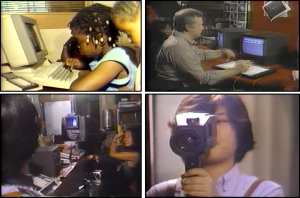
At a pivotal moment in the history of telecommunication, Electronic Café was a call for innovation in just this sense. It presented new devices as instruments of critical social labor, as ways to produce new publics, new sets of political relations. By placing these devices in the hands of local communities for ostensibly unrestricted and uninstructed use, Mobile Image encouraged participants to take ownership of tools that were not yet generally available, not yet prescribed by habits and imposed protocols, not yet usurped by higher forces. Electronic Café suggested a different technological order, in which technologies are shaped by the shared concerns and potentials of common users, instead of by controlling forces of capital and power (fig. 2). As Galloway explains, “We wanted to own this technology with our imagination so that when it comes knocking you know what to do with it.”8 The work presented new ways of perceiving, of being in the world. It drew attention to gaps between narrowly defined givens and more expansive possibilities, while offering a path toward bridging them—toward true technological innovation. Users would get a glimpse of an emerging techno-social capacity, of practices that could at once create an awareness of and productively breach presumed constraints and the power dynamics sustained by those constraints. Electronic Café re-presented public use as a form of conscious grassroots resistance against an already internalized authoritarian technological regime—a regime perpetuated by the mythological promise of a dazzling future via ceaseless invention (fig. 3).
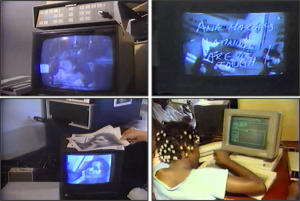
Electronic Café was the culmination of a three-stage Mobile Image trajectory, each represented by a major project. The first, Satellite Arts (The Image as Place), 1977 (fig. 4), was a set of improvisational dance collaborations performed by individuals in two locations—the Goddard Space Flight Center (Greenbelt, MD) and the Ames Research Center (Mountain View, CA)—joined via bi-directional satellite uplink. While watching the live video transmission from alternate sites, the dancers coordinated their movements to align with those of their displaced partners. Mobile Image conceived of these performances as “tests,” the results of which were only complete within the space of a composite television display. This display—an “image as place”—was not simply a screen that frames and reproduces a camera’s view, but a distinct arena with its own laws of time and space, a “visual architecture” existing in a parallel, but no less authentic, reality.9 Satellite Arts presented technology as an extension of both the physical body and the self in space and time, demonstrating possibilities for “genuine experience” via telecommunications. To Mobile Image, this conception could be politically potent, initiating new forms of resistance against then-current norms of social and spatial interaction, which were more often than not limited to an extension and imposition of private attitudes and interests. The work was set against what the artists saw as the threat of “cultural imperialism through electronics.”10
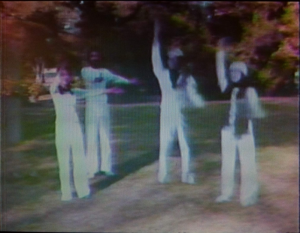
Their next major project, Hole-in-Space, 1980 (fig. 5), was at once simpler and more expansive. Subtitled “A Public Communication Sculpture,” the work consisted of two large screens—one in New York, one in Los Angeles—linked by live satellite feed. For two hours per day, over three successive evenings, people could see, hear, and interact with one another in real time from opposite sides of the country. Unannounced and with no preset rules, the work presented a new kind of social experience, a demonstration of what the artists called a “globally distributed electronic commons.”11 Unlike Satellite Arts, Hole-in-Space neither established an alternative arena in the screen, nor instructed participants to perform in certain ways.12 Rather than set up a virtual location, the work dissolved geographical barriers and allowed people to use the arrangement however they saw fit. The essential objective was to open up new possibilities for technologically generated social exchange and community. Mobile Image thus transitioned from an arena of experimental art and performance to “real life” intervention and interaction, from the magical space of the autonomous screen (e.g., Satellite Arts) to direct and self-reflective public use and the social possibilities spawned by relatively unrestricted communication systems. Here, innovation was a matter not of new technological capabilities—indeed, such capabilities had been around for decades by that point—but of expanded use. Several participants acknowledged this and expressed frustration that it had not come sooner. “It’s fantastic!” one exclaimed, “Except they could have done it 25-30 years ago. Why didn’t they?”13 These moments of recognition were crucial: it was then that audience members realized that certain technologies are circumscribed by ownership and power, that they actually have multiple ways of functioning—some emphasized, some repressed.

Electronic Café can be seen as a network of holes-in-public-space, but with substantially more control granted to the users and a greater political intention. The work meshed multiple public domains: traditional community meeting places; the “deterritorialized” zone of the telecommunication network; the highly territorial geography of the segregated city; and the specific ethnic and racial identities mapped onto that geography. In fact, the artists deliberately selected spaces defined by their relative proximity to the productive apparatus of cultural norms and expectations: a museum; a paradigmatically alternative or countercultural community (Venice Beach); and multiple minority-based neighborhoods distinct in their experiences of marginalization (South Central, Koreatown, East LA). As the artists explained, “by integrating multiple-media telecollaborative technologies with the culturally diverse creative communities throughout Los Angeles . . . a powerful new context for cultural sharing and interaction would emerge.”14 To them, such technologies were not mere substitutes for or simulations of face-to-face contact: “not just the next best thing to being there; sometimes they’re better than being there.”15
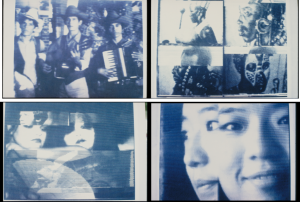
The various devices they made available enabled an array of communication possibilities beyond geographic location, not restrained by antagonisms between communities, and not bound by traditional means, yet at least initially defined by preexisting notions of cultural difference and expectations of how one would in turn be perceived. The slow-scan cameras and drawing tablets, for instance, allowed for the exchange of imagery between individuals, some of whom did not have a common verbal language. Participants shared pictures loaded with specific ethnic and cultural connotations (fig. 6). Recipients then reprocessed some of those transmissions, producing additional, and more complex, communications. Original screenshots were thus enriched—juxtaposed, superimposed, reassembled, drawn on, adorned with written commentaries—and then sent back out across the network (fig. 7). Real-time, digitally produced photomontage became a primary language of cross-cultural exchange and collaboration, encouraging users to scrutinize given categories of similarity and difference as well as their relation to a shared apparatus of experience.
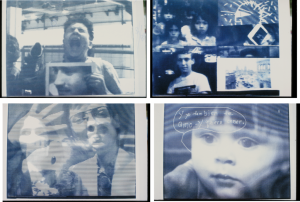
Similar results occurred via Electronic Café’s computerized bulletin board system (BBS). A customized version of Community Memory, the first public BBS, established in the mid-1970s in Berkeley, California, the system allowed users to post text and images that could then be retrieved and further commented upon by other users. This not only enabled an exchange of information, but formed a cumulative, searchable database that could serve as a space for public interaction and identity formation, facilitating fresh relationships and serving the particular needs of the community. Indeed, Community Memory was explicitly designed to function as an archive, as a site for collecting alternate histories, and as a platform for political organization and “decision-making.”16 Mobile Image was also drawn to its customizable, thematically based filing scheme that could incorporate a potentially limitless diversity of ideas and issues—high and low, public and private. Along with preset general “index words” (e.g., “music,” “food,” “sex”) and additional ones geared towards local and historically specific concerns (e.g., “housing,” “nuclear,” “women”), the database could be enriched by any number of new categories entered on-site by users. The network revealed any “community memory” as reliant on pre-constructed topics, which inevitably limit identity parameters and any exchange conducted thereon. It presented an opportunity to produce additional associations and relations.
Participants shared personal stories, proverbs, and perspectives. Topics ranged from the plight of South American refugees and culturally entrenched sexism and racism, poverty, and lack of education to schoolchildren wanting to find pen pals from other communities across LA. As with the slow-scan image exchanges, these BBS communications often built upon one another, transgressing boundaries, forging connections, and articulating common causes. Though some of the postings may seem frivolous, they represent a type of exchange that negotiates between preexisting parameters, protocols, and identities, and at times, seemingly incompatible everyday expressions and desires.
Electronic Café was an embryonic network of public community-building, of interaction and collaboration among people who may not have been willing or able to otherwise do so. Participants used telecommunications in new ways, while becoming aware of the extraordinary conditions of that practice and the fresh possibilities opened up by it. This contrasted with more restrictive, official, commercially, and governmentally prescribed arrangements of production and consumption—arrangements enabled, in part, by the recurrent, almost fetishistic adulation of new devices. Mobile Image carefully designed its state-of-the-art network so that its complexity would fade into the background, rendering it as user-friendly as possible. As they explained, participants “were confronted with about $70,000 worth of equipment in each café, but the technology was transparent enough that they came away with the quality of the human experience they had.”17 This “transparency” helped foreground the broader social aspects of the network alongside the futuristic machinery, provoking a consideration of electronic exchange itself.18 Such self-consciousness and criticality among users inhibited the romanticization of technological progress and concomitant myths of greater unity, harmony, and democracy via a technology-for-all ethos. In Brecht’s terms, Electronic Café sought to upend existing social orders rather than reinforce (or “renovate”) them.
Indeed, several users recognized the political potential of the kind of communication heralded by the experimental network. Some spoke of it as a more productive alternative to the frustrating state of mainstream television and radio. As one Community Memory post explained, “the main limitation to communications technology is and always will be the content of the programming. Gilligan’s Island transmitted by direct-broadcast-satellite is still trash.”19 Mainstream media was understood as massifying its audience under the guise of choice by extending the reach of consumable information, the heterogeneity of entertainment, and the clarity of images, rather than by increasing the transparency of their production. Indeed, the forms of spectatorship that were rapidly emerging at this time—video playback, satellite, cable systems—may have offered more variety, but they resulted in increasingly distracted, privatized, and fragmented acts of consumption.20 Access to devices alone is not enough; their corporate control precludes progressive use. Another post summed up the situation:
I think the ELECTRONIC CAFE is a wonderful opportunity for the community(s) to define what we want of a communication system. . . . It is clear that the corporations already have this technology at their disposal . . . It is now time for all of us to determine our own future by thinking PRACTICALLY about what kinds of uses and creations we can use it for. I like the idea that this is in cafes all over the city because at the very least that is what we all have in common.21
The ambivalence expressed by such users reflected a broader historical moment of shifting views on technology and its social function. The late 1970s and early-to-mid-1980s was a period of rapid technological development and enthusiastic public anticipation of a spectacular future generated by advances in computer equipment and telecommunication networks. This was a key moment in the cultural history of technology, in which a late 1960s and early 1970s view of electronic media as a path toward collaborative social practice, transformed consciousness, and flattened hierarchies transitioned into the late 1980s and 1990s “new economy,” built on a paradoxical mix of counterculture aesthetics, libertarian politics, and techno-utopianism.22 The emergence of more accessible technologies and “personal computing” coincided with greater centralization, privatization, and deregulation of telecommunication systems. Motivated by persistent myths of progress, citizens generally embraced new devices without scrutinizing the social contracts shaped and sustained by them.23
To Mobile Image, it was imperative to eschew such myths and look instead at the real-world functioning of technology, to consider its wider effects, and participate in the development of its uses and use-value. Moreover, they presented technology, and especially communication technology, as fundamentally relational—again, as a means of critical social labor. In their 1993 book Public Sphere and Experience, Oskar Negt and Alexander Kluge distinguish between events considered public (elections, Olympic ceremonies, warfare, a theater premiere) and those considered private (childrearing, factory work, watching television at home). However, they explain, “the real social experiences of human beings . . . cut across such divisions.”24 Electronic Café provided the mechanism for just such social experiences, and for their scrutiny. By negotiating the material and ideological sites of production—of normative ideas, behaviors, and identities on the one hand, and ostensibly incompatible histories, desires, and experiences on the other, of the “public” and the “private”—users could attain a technological consciousness with the potential to complicate, and ultimately transcend, such binaries. On the eve of a massive citywide spectacle billed as a paragon of international unity and aided by technological sophistication, Electronic Café represented an alternative model, a way of achieving true innovation, as opposed to renovation. It was devised so that common users could critically articulate their existing and potential social subjectivities via new tools, empowering them to produce fresh arrangements of images, ideas, knowledge and conduct, transgress boundaries, and hence form new connections according to shared concerns—concerns that may or not have been consistent with the “Olympic spirit.”
DOI: https://doi.org/10.24926/24716839.1536
PDF: Levine and Glahn – Interrogating-Invention
Notes
- “New Technology Permeates an Age-Old Tradition,” InfoWorld 6, no. 31 (July 30, 1984): 27. ↵
- Los Angeles Olympic Organizing Committee, Richard B. Perelman, ed., Official Report of the Games of the XXIII Olympiad, Los Angeles, 1984, Volume 1: Organization and Planning (Los Angeles Olympic Organizing Committee, 1985), 43–56. ↵
- “New Technology Permeates an Age-Old Tradition,” 27. ↵
- Robert Fitzpatrick, “The Olympic Arts Festival,” Olympic Review, no. 198 (April 1984): 247. ↵
- Mobile Image, “Kit Galloway and Sherrie Rabinowitz” recorded artist talk at Southern California Institute of Architecture, February 10, 1988: http://sma.sciarc.edu/video/kit-galloway-and-sherrie-rabinowitz/ (accessed 02/15/2015). ↵
- Official Report of the Games of the XXIII Olympiad, Los Angeles, 1984, 528. ↵
- Bertolt Brecht, “The Radio as an Apparatus of Communication,” 1932, in Brecht on Theatre: The Development of an Aesthetic, ed. John Willett (New York: Hill and Wang, 1996), 53. ↵
- Kit Galloway, interview with the authors, 09/19/2015. ↵
- Kris Paulsen, “‘Image as Place’: The Phenomenal Screen in Kit Galloway & Sherrie Rabinowitz’s Satellite Arts 1977,” Leonardo Electronic Almanac (LEA) 19, no. 2 (April 2013): 102. “Visual architecture” is Sherrie Rabinowitz’s term (quoted in Steven Durland, “Defining the Image as Place: A Conversation with Kit Galloway, Sherrie Rabinowitz & Gene Youngblood,” High Performance 37 (1987): http://www.ecafe.com/museum/hp_gy_1987/hp_gy_1987.html (accessed 02/10/2015). ↵
- Mobile Image, “Kit Galloway and Sherrie Rabinowitz” recorded artist talk at Southern California Institute of Architecture. ↵
- Quoted in Chandler, A., “Animating the Social: Mobile Image/Kit Galloway and Sherrie Rabinowitz,” in At a Distance: Precursors to Art and Activism on the Internet, ed. by Annemarie Chandler and Norie Neumark (Cambridge, Mass. and London: MIT Press, 2005), 164. ↵
- Marc Ries, “Rendezvous: the Discovery of Pure Sociality in Early Net Art,” in Net Pioneers 1.0: Contextualizing Net-Based Art, ed. by Dieter Daniels and Gunther Reisinger (NY: Sternberg Press, 2009), 69. ↵
- Anonymous viewer, video documentation of Hole-in-Space, produced by Mobile Image, Nov. 11, 13, and 14, 1980. ↵
- Mobile Image, artists’ website: http://www.ecafe.com/getty/table.html – 4 (accessed 02/07/2015). ↵
- Mobile Image, “Kit Galloway and Sherrie Rabinowitz” recorded artist talk, 1988. ↵
- The Community Memory Project: An Introduction (1982), 1. From the personal archive of Kit Galloway. ↵
- Sherrie Rabinowitz, quoted in Snowden, D., “Mobile Image Works on a Global Vision,” Los Angeles Times (October 19, 1987) Retrieved from: http://articles.latimes.com/1987-10-19/entertainment/ca-10362_1_temporary-contemporary (accessed 02/09/2015). ↵
- Ries, 69. ↵
- Anonymous user, post titled “The Gilligan’s Island Syndrome,” Electronic Café Community Memory archive, Kit Galloway personal collection. ↵
- Miriam Hansen, “Early Cinema, Late Cinema: Transformations of the Public Sphere,” in Viewing Positions: Ways of Seeing Film, ed. Linda Williams (New Brunswick, NJ: Rutgers University Press, 1994), 135. ↵
- Anonymous user, post titled “THOUGHTS ABOUT ELECTRONIC CAFE,” Electronic Café Community Memory archive, Kit Galloway personal collection. ↵
- Fred Turner, From Counterculture to Cyberculture: Stewart Brand, the Whole Earth Network, and the Rise of Digital Utopianism (Chicago and London: University of Chicago Press, 2006), 208–9. ↵
- Langdon Winner, “Technologies as Forms of Life,” in The Whale and the Reactor: A Search for Limits in an Age of High Technology, (Chicago and London: University of Chicago Press, 1986), 9. ↵
- Oskar Negt and Alexander Kluge, The Public Sphere and Experience (Minneapolis: University of Minnesota Press, 1993), xliii. ↵
About the Author(s): Cary Levine is at the University of North Carolina, Chapel Hill, and Philip Glahn is at the Tyler School of Art, Temple University

